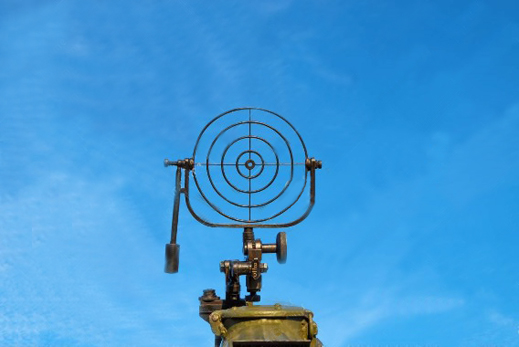
By John Helmer, Moscow
First there was the red-line announcement. On Friday in Athens there was the cross-hairs statement. By the month of October, the month before the US presidential election, there will be the trigger point.
The US and the North Atlantic Treaty Organization (NATO) allies are going to war with Russia, accelerating the inevitability that Russia will strike in self-defence. This is what the first and second statements by President Vladimir Putin warn. There will be no statement of warning when the trigger point arrives.
At his press conference in Athens on Friday, Putin warned that the installation of an Aegis anti-missile base in Romania, operational this month, and the rush to do the same in Poland, are hostile acts, just short of casus belli — cause of war.
To make this clear, Putin used a vivid phrase — ???? ??? ????????. It refers to gunsights or cross-hairs for targeting army artillery, airforce cannon, or naval torpedoes.
Putin was translated by Reuters as saying: “If yesterday in those areas of Romania people simply did not know what it means to be in the cross-hairs, then today we will be forced to carry out certain measures to ensure our security,’ Putin told a joint news conference in Athens with Greek Prime Minister Alexis Tsipras. ‘It will be the same case with Poland,’ he said.” Read the Reuters report in full.
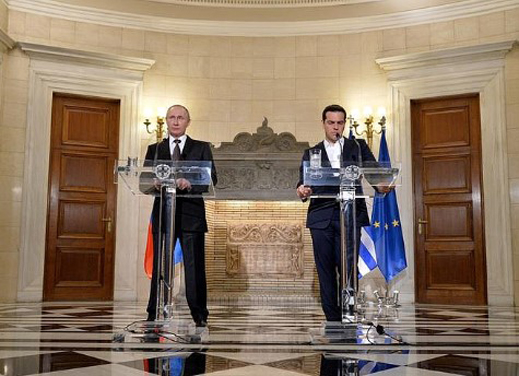
Source: http://en.kremlin.ru/events/president/news/52024
Putin was talking about the Romanian base at Deveselu, 180 kilometres south of Bucharest, the Romanian capital; and Redzikowo, 460 kms north of Warsaw, the Polish capital. A diagram, published by the BBC, makes it appear these US missile bases (right side of diagram) respond to an initial missile strike by the Russian side (left):
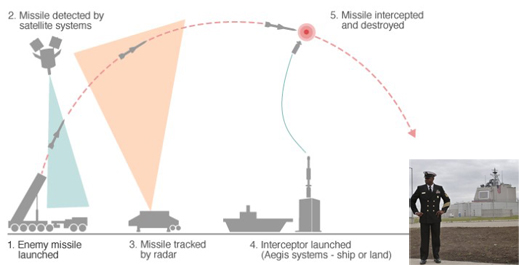
The BBC also reports the NATO claim that the range and firepower of the Romanian and Polish bases are too far apart and too limited in range to threaten a first-strike attack on Russia.
In fact, as Putin announced on Friday, the Romanian and Polish batteries are capable of firing first, and at a range of 2,400 kms, to strike at Russian missile targets, before launch, as far as the line between the Plesetsk and Tyuratam missile command centres.
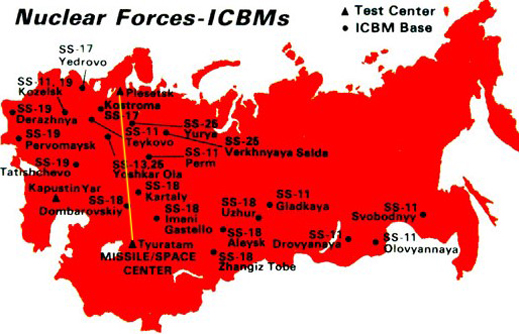
The range extensions of the Aegis system, operating both west to east and east to west, were mapped by the Federation of American Scientists (FAS) in a report of September 2011.

“In all cases above,” the FAS scientists Yousaf Butt and Theodore Postol concluded, “the theoretical [US, NATO] defensive capability would be degraded if the incoming [Russian] ICBMs carry countermeasures or decoy warheads.”
That didn’t mean that the Russian side could (should) underestimate the US intention and capability to attack first successfully, or overestimate the Russian capability to do the same. Strategy must be based on defending against the worst case, Butt and Postol explained. “While it is true that the Russians could defeat the SM-3 interceptors by using decoys and other countermeasures, it is also true that their military planners would have little choice but to entertain the possibility, however remote, of a ‘worst-case’ scenario in which U.S. missile defense interceptors could be more effective than expected, or Russian countermeasures less effective. In other words, the potential threat to Russian nuclear deterrent forces from the U.S. missile defense system will likely be judged by the ability of the interceptors to reach and engage Russian warheads – not by whether or not every such engagement results in a kill.”
Reach or range is the key.
The FAS report recommended the best way of confirming the US and NATO claims for the limited intention of the Aegis system is to restrict its range. Without that concession to Russian (also Chinese) security concerns, the report concluded the entire system “threaten[s] to provoke Russia’s exit from New START [Strategic Arms Reduction Treaty], in addition to possibly restarting a nuclear arms race – while providing no credible defense against possible future Iranian or North Korean missiles hosting simple countermeasures. Russia and China might increase their arsenals, end future arms reductions talks with the United States, and decrease their assistance with worldwide counter-proliferation efforts. Such a result would diminish U.S. – and global – security and would be at odds with President Obama’s vision of a nuclear-weapons-free world.”
That was published in September 2011. Since then, instead of restricting range and negotiating reciprocal assurances against first-strike attacks, the US has advanced its sea and land attack capabilities closer to the Russian border, and extended the potential range and precision of their firepower.
For the Russian warnings to the close approach of US Navy missile warships, such as the USS Donald Cook, in the Black and Baltic Seas, read this from April 2014, and thisfrom April 2016. For Putin’s red-line warning, read this.
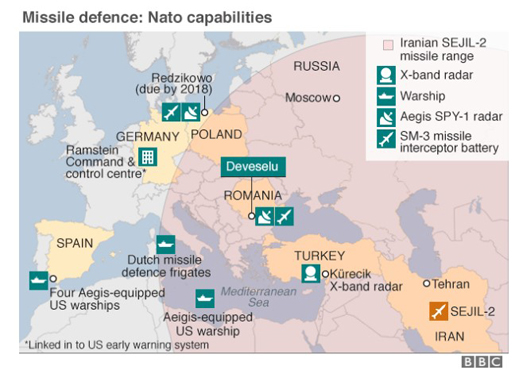
Last Friday, when Putin used “cross-hairs” in his warning, the Reuters report was an accurate translation of the Kremlin’s transcript in Russian.
In the Kremlin’s English translation, the impact of the cross-hairs warning was softened slightly. Putin was translated as saying: “if yesterday some areas in Romania did not know what it is like to be a target, today we will have to take action to ensure our security.”
For soldiers and strategists on both sides, this isn’t exactly new. Like the Federation of Atomic Scientists, Russian think-tanks, government officials and military officers have been making such cautionary statements for many years. What is new is the precision of Putin’s speech, and the shortening of the time fuze.
Read Putin’s full statement on the point: “What is the impact of security-related issues on economic cooperation, in particular, the commissioning of the US anti-missile defence deployment area in Romania? What is the impact? The impact is negative, and it cannot be otherwise. Because some time ago the United States unilaterally withdrew from the Anti-Missile Defence Treaty and started what amounts to undermining the fundamentals of international security. Yet another step has been made now.
“Since the early 2000s, we have been persistently repeating the same thing, like a mantra: we will have to respond to it in some way. Nobody listens to us, nobody is willing to have talks with us, we do not hear anything but platitudes, and those platitudes mainly boil down to the fact that this is not directed against Russia and does not threaten Russia’s security.
“Let me remind you that initially there was talk about thwarting a threat from Iran, it was all about the Iranian nuclear programme. Where is the Iranian nuclear programme now? It no longer exists. The Unites States themselves initiated the signing of the treaty with Iran. The Iranian nuclear threat does not exist, while the US anti-missile deployment area is being created and was commissioned in Romania.
“What is this? These are launch pads and radar stations. Today, 500-kilometre range Iskander land-based missiles are being deployed; in a few years they will be 1000-kilometre range missiles. We even know the approximate date when such missiles will be deployed. How can this not be a threat to us? It is a clear threat to our nuclear forces.
“However, there is something else that is even worse: these compact launch pads can accommodate assault missiles with a 2,400-kilometre range, and replacing the missiles is no problem, one only has to change the software, and nobody is going to notice anything, even the Romanians. Isn’t it a threat to us? It certainly is.
“That is the reason we have to respond now, and if yesterday some areas in Romania did not know what it is like to be a target, today we will have to take action to ensure our security. Let me repeat, these are response measures, a response only. We were not the first to take such steps.
“The same will be done with regard to Poland. We will wait for certain actions to be taken in Poland. We are not going to do anything until we see missiles on the neighbouring territory. And we have the necessary resources. You saw, the whole world saw our capabilities in terms of medium-range sea and air based missiles. We are not violating anything, but the Iskander land-based missile systems have a brilliant record.
“Incidentally, the fact that launch pads are deployed that may be charged with medium-range missiles is nothing short of erosion of the medium and short range missile treaty by our American partners. I think it is an obvious matter that requires the most careful consideration, and undoubtedly, the involvement of the parties concerned in detailed and substantial talks on these issues.”
There is almost no ambiguity. As Putin said in his red-line speech in March 2014, after the putsch in Kiev triggered the Crimean vote to join the Russian Federation, “there is a limit to everything. And with Ukraine, our western partners have crossed the line.” For analysis of the significance in Russia’s new war strategy, read this.
Two years later, Putin is saying, not from the Kremlin, but from the entrance of Megaro Maximou, that Romania has crossed the red line, and is now inside the cross-hairs. The location for Putin to say this is not without significance. It has been the official headquarters of the Greek Prime Ministry since the Greek left came to power in 1982. It has also been a headquarters of two of the states which have occupied Greece by military force – Germany between 1941 and 1944, and the US until 1952.
Putin is reminding Romania and Poland that they are occupied states, and that if they are counting on the missile bases and Article 5 of the NATO treaty — they won’t be a reliable shield, when the radioactive wind blows, for their national capitals. For Romania, it’s too late. For Poland, there is still time for mutual and reciprocal security agreements, maybe along the lines recommended by the Federation of Atomic Scientists; maybe, as Putin expressed it, by “the most careful consideration, and undoubtedly, the involvement of the parties concerned in detailed and substantial talks on these issues.”
Expressed this way from the capital of a country crushed today by the occupation of the European Union’s forces, the invitation to the Poles is to save themselves before Poland’s time runs out, again. The original agreement for the Redzikowo missile base was signed in 2010 by Radoslav Sikorski(below, left) and Hillary Clinton (right). Sikorski was Poland’s foreign minister at the time. Today, stripped of all official posts, he is under criminal investigation in Warsaw, living in exile between the US and US, and dependent on his wife’s earnings from US government operations. Clinton is under criminal investigation in Washington, and in a close race for the US presidential election, due on November 8.

It has taken two years of escalating warfare between Washington and Moscow before the cross-hairs warning. What then is the timing between now and trigger point? Where will the trigger be pointed, and how will it be pulled?
The likely timing, according to Russian assessments, is the month of October. The history of the “October Surprise” by desperate US presidential runners to pull off a last-minute election victory is well-known. The last military operation directly connected to a presidential election was President Jimmy Carter’s abortive attempt to rescue the US Embassy hostages in Tehran in April 1980, and then the subsequent manipulation of negotiations with the Iranian government for their release. The last US war to fix the outcome of a presidential election was President Dustin Hoffman’s (below, right) war with Albania in the film, Wag the Dog.
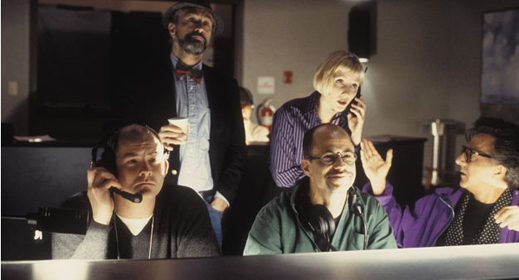
By October, the weak outgoing President Barack Obama will be prodded by the weak, failing Democratic Party candidate Hillary Clinton to rescue her chances and rally reluctant American voters against the Republican candidate, Donald Trump. The October surprise this year, Russians believe, will be a violent one. For cross-hairs this year, Albania doesn’t qualify. Clinton can’t afford another adventure in Libya.
Victoria Nuland (below, left), Samantha Power (centre), Michele Flournoy (right) — the women around Clinton, who will lose promotion and power if Clinton loses to Trump — have already tried and failed in Ukraine, Syria, Iraq and Turkey. Romania almost qualifies.

But can and will the Russians assist Trump in his counterstroke — a Reagan-type, Tehran-type October surprise?
Gennady Nechaev (below, left), a leading military analyst at Versiya and Vzglyad in Moscow, says that priority targeting in Russian strategy continues to be the “key military infrastructure: airbase positional missile areas, ports and naval bases, depots and places where the ground forces are based. First and foremost, this concerns the countries of the ‘old NATO’, where everything has been established for decades. In this targeting, maximum damage would be incurred by Germany and the UK, followed by France and Turkey; as well as the south of Italy and the coast of Northern Europe.”
Is there Russian military contemplation of a new trigger point, and soon? “ I do not think this is possible,” Nechaev replies. “During the entire existence of the [Warsaw Pact-NATO] bloc system, such incidents can be counted on your fingers. Then the intensity of aviation operations at the borders has been several times higher than now. There is the possibility of a chance encounter in the air because of pilot errors or gung-ho flyboys. This happened before. It can’t be excluded again.”

Yevgeny Krutikov (above, right), also a leading military analyst in Moscow, and once a serving officer himself in the Balkans, says: “any state of NATO, which takes on commitments to destabilize the general situation could be in the gunsights. The military circumstances determine this. If like Romania you host an anti- missile system, automatically it means that the system becomes a target, and may be attacked by medium-range missiles like Iskander, ballistic missiles, or something worse. To pinpoint someone as a certain target is difficult. Any NATO state, which changes the balance , will automatically be targeted in the cross-hairs. People need to understand they will suffer if something happens. So I cannot say that someone in particular has been selected. They are all under the gun.”
In Krutikov’s assessment, at the moment military targets in the Baltic states are “less relevant. What is happening there is at the level of ethnic panic. They have no external [NATO] forces, and what there is, is a handful of tanks that are no more than a caricature. In the Arctic zone, there is a problem, but it is a very large area, and it needs to be divided into theatres of war. A special danger right now is the situation around the Barents Sea, since that is where clashes between Russia and NATO have been taking place, and where maneuvers are being repeated, primarily by the United States. Just a month ago, the latest of them was finished. Involved in that one, were not only NATO but also the Finns and the Swedes, who are not members of NATO. The Arctic cannot be the biggest problem area, because no NATO country has an icebreaking fleet, oddly enough.”
“In the Sea of Japan, yes, there is a rapid build-up of Russian armed forces on the Kurile Islands, which, without effective supporting infrastructure, didn’t exist before. Accordingly, there is increased interest on the part of the Americans. In my opinion, already there have been at least two American attempts to penetrate with reconnaissance aircraft, so naturally there has been a backlash from Russia.”
In the weeks ahead, according to Krutikov, the trigger points are not where the strategic interests are greatest, but where the space for manoeuvre between Russian forces and their enemies is smallest. They are the Baltic and Black Seas. At their widest points, east to west, the distance in the Baltic is 193 kms; the Black Sea, 1,175 kms. In the narrows between the Romanian port of Constanta and the Russian naval headquarters at Sevastopol, the distance is just 392 kms.
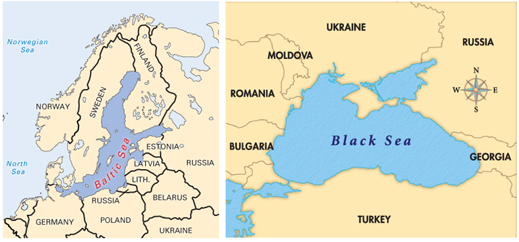
Krutikov: “The Baltic is very small. Into and out of the Kaliningrad region Russian planes must fly from the northwestern and adjacent districts, where there is a very large number of military airfields and where flights in the direction of Kaliningrad must observe a certain order. There is an extremely nervous reaction from the Baltic states, which don’t have their own aircraft. So there are shifts of patrols such as the Danes and now Portuguese. When Russian aircraft are flying in the right space, those poor Portuguese must chase and watch them. This is a problem because people are nervous. When the situation is as tense as this, something could happen. This is the most dangerous situation, just because there is no place to escape. There is too little space.”
“There is also very little space in the Black Sea. A week and a half ago, NATO forces began maneuvers in the Black Sea, in the north-western part of the area around Odessa. Suddenly, there is a concentration of a very large number of foreign ships — Romanian, Bulgarian, Turkish, American. God forbid, that damned Donald Cook. There is also very little space. The Black Sea is a puddle, maybe a little more than the Balti? puddle , but still there is no place to turn around. Therefore, such hysteria as there is may cause problems.”
NOTE ON THE BENCKENDWARF SYNDROME: enemy capabilities are for Russian intelligence to measure. Gauging the intentions of the enemy is prone to the Benckendwarf Syndrome. Confusing capabilities by mistaking intentions is Benckendwarfism – this is the distortion caused by Russian policymakers who think they understand the British, Germans, Turks or the Americans better than their colleagues because they speak the language, are sympathetic to the culture, or have money, assets or children in their safekeeping.
The syndrome is named after Count Alexander Benckendorff (below, left), the Anglophile Russian ambassador in London from 1903 to 1917. He dominated the pro-British line in Russian strategy — the Tsar’s as well as several foreign ministers’ — in the years and events leading to World War I in 1914. Just as dwarfish, but in favour of the Germans, was Baron Roman Rosen (right).
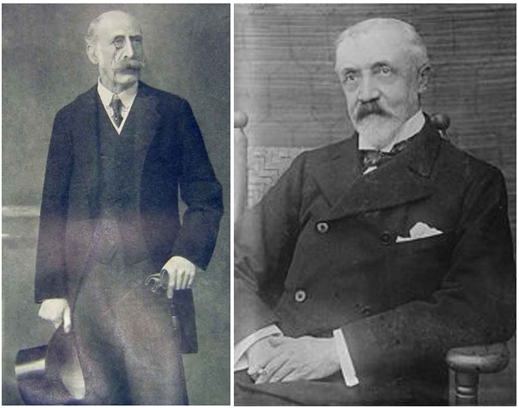
In Anglo-American policymaking the syndrome is called Going Native. Putin himself has suffered from the syndrome; his enemies, not his friends, have cured him. For more details of Benckendwarfism, read Dominic Lieven, Towards the Flame, Empire , War and the End of Tsarist Russia, published last year.